hours 805 to 806
London Nights Photography Exhibition Review
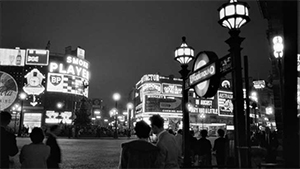
© Estate of Bob Collins/Museum of London
The exhibition at the Museum of London spans the period from the start of the 20th Century (pretty much the dawn of photography) to the present day, covering the genres and styles that have been popular throughout this period, including:
- Pictorialism
- Portraiture
- Conceptual
- Film.
The cohesive objective of the exhibition is to show how both the night-time character of London has changed over this period, and how its depiction through photography has also changed as the art form has developed.
Most contemporary is the image by Tim Peak taken from the International Space Station.
My objective with this post is to encourage anybody who hasn’t been to go. If you’ve been and disagree with me, I would love to hear from you, either through the comments box below or through the social media channel of you choice right.
Early Photographs
One of the first images in the exhibition is a 1909 image of Leicester Square, in what looks like wet if not actually rainy conditions by Alvin Langdon Coburn. Athough born in America, Coburn was a member of the influential London based photography club, the Linked Ring. See my post: “First Notes on the History of Photography as an Art Form.”
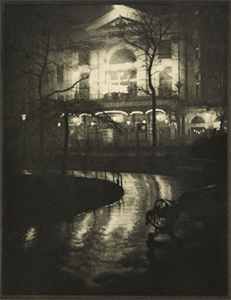
What is striking about these early images is the detail and tonal quality, even when measured by modern standards. Baring in mind the burdensome process of producing an image at the start of the 20th Century, the additional challenges of night photography make these images all the more remarkable. Exposures lasted for several minutes and photographers were known to have placed a hat in front of the lens to avoid light contamination should a hansom-cab pass by.
The image, courtesy Museum of London, left shows Empire Theatre with atmospheric reflections from the wet pavements.
Technically a photogravure, which was an early technique pioneered by Nicephore Niepce (France) and Henry Fox Talbot (England), where an image is etched onto a metal plate.
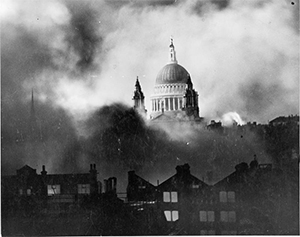
There are of course many images showing life in London at night during the Second World War, including people sleeping in the Underground and other emergency shelters.
The image right shows the chaos and terror surrounding St. Paul’s Cathedral, which remarkably survived the blitz. The lighting implies a divine protection against the evils of the war.
The photograph was taken during the night raid of the 29/30 December 1940 by Herbert Mason from the the roof of the Daily Mail building.
Now one of the most famous images of the war and according to Andrew Saint, has become “a symbol of togetherness, survival and suffering”.
Street Photography Ancient and Modern
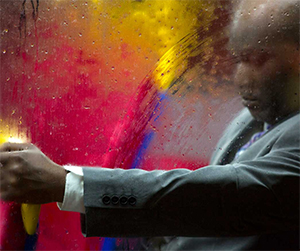
The majority of the exhibition is a mixture of candid and posed images throughout the period covered.
Particular favourites of mine are the images by Nick Turpin from the “On the Night Bus” series. These colurful images, showing people on a bus late at night, were shot from the first floor of an adjacent building using a long lens.
The sense of time and place is enhanced by steamed up bus windows and raindrops partially obscuring the subject who is invariably “a Londoner” going about their daily/ nightly business.
A simple concept, well executed.
From the images of nightclubs through the ages, I was struck by the similarity between clubbers of the 1920s, 1960s and the present day. Fashions and tastes in music change, but the excitement of a night on the town remains constant.
The exhibition also deals head on with the seedier side of London: the sex trade through the previous century to the present day, and the intimidating dark Streets.
Urban Landscapes
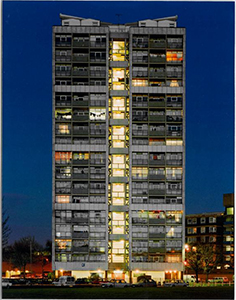
The exhibition covers images of landmark London buildings at night, sometimes photographed at significant times historically. Such as the illumination of the Houses of Parliament to celebrate the end of WWII when it was presumably blacked out like all other buildings in London.
More modern images such as that of the Brandon Estate, Kennington Park, Lambeth, left, provides an enticing glimpse of the nocturnal life of more contemporary Londoners. The seemingly randomly illuminated flats indicate activity therein, whereas the streetlights and cars at the base of the tower suggests life outside.
Also represented are equally gritty, yet lower level, images from Clerkenwell and The Isle of Dogs by Colin O’Brien and Peter Marlow respectively.
A more positive series of images, by Lewis Bush from the series “Metropole” 2015, shows London in a state of continual renewal and development. Striking modern black and white architectural photography.
Conceptual Photography
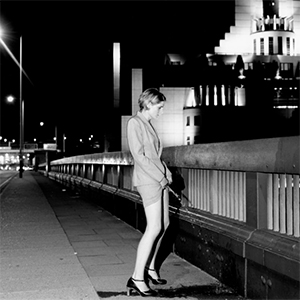
Sophy Rickett’s “Pissing woman”, one of a series of self-portraits where she challenges sexual stereotypes by defiling the city’s pavements, is one of the exhibition’s most striking images. Dressed in a power-suit with mini-skirt pulled up at the front, she stands like a man at a urinal; every inch the confident, self-assured woman; feminine, yet pissing like a man.
The image continues to cause a controversy. One reviewer of the exhibition’s accompanying book on Amazon described the image as: “A juvenile provocative image of a tran-gender [sic] lady brazenly relieving herself on a bridge was calculated to upset Daily Mail readers.” I tried to reply to this comment, but I am apparently not “in good standing with the Amazon Community.” (My first experience of being a social outcast.)
There are many other conceptual works presented in the exhibition. Some more immediately accessible than others. “Dialogue with a Rapist 1978 Bermondsey London“, Alexis Hunter’s series of images which symbolically tell the story of the attempted assault on the author herself alongside the written narrative. The horror of the incident itself and relief at the outcome leave a disturbing sense of social unease that make this one of the most thought provoking exhibits presented.
Further Posts and Comments
I hope to attend one of the series of talks organised by the Museum of London around this exhibition and having done so, will update this post. My goal with this 10,000 hour project is to learn, if you have any comments or suggestions, please post them below.
To see more posts on other photographic topics, or to follow my learning progress, please like or follow me on the social media channel of your choice to the right.
The photographs reproduced in this post are the work of other artists. It is my intention to respect the copyright associated with these images in line with the Fair Use principle. Wherever possible I have acknowledged the author and/or reproduced Copyright information, and linked the image to the artists own website.